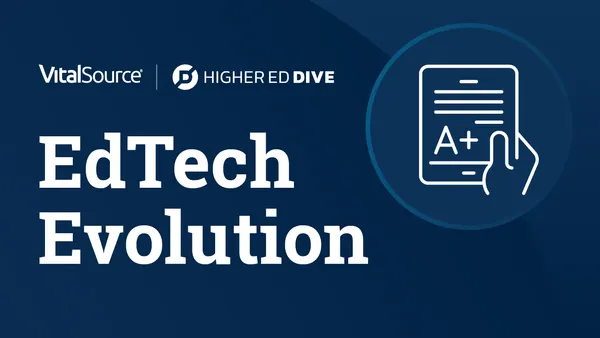Dive brief:
- Colleges providing online learning are finding the courses must be updated to keep material and techniques up-to-date, and that process sometimes is more complex and expensive than many assume, according to Inside Higher Education.
- The report describes how some institutions are trying to develop formulas for the return on investment for the courses as they begin to recognize the courses are not necessarily self-sustaining and need to be upgraded periodically. One official said that only a handful of colleges do quality assurance and continuous improvement well, though it is increasingly on the minds of college officials.
- It notes that the content for some courses, such as political science or information technology, changes quickly, and that digital technology might become “clunky or defunct” for others and require other changes.
Dive Insight:
Higher education institutions, which often moved into the digital realm quickly, are now finding that they need to assess their offerings for their effectiveness. Cornell University, for instance, has web pages from its Center for Teaching Innovation not only about establishing an online course, but also about redesigning it, with information about how those offering online courses should consider the course objectives and “work backward to evaluate teaching strategies” and decide whether the courses “yield appropriate evidence of student learning.” It says professors should measure and examine outcomes and consider whether the students were engaged, the resources were useful and the assessments accurately measured learning.
Ohio State University started a distance education office five years ago with the goal of formalizing review processes for the institution’s growing digital learning offerings, and Western Governors University in Salt Lake City has a faculty team that evaluates courses based on learning outcomes, design and resources used.
The University of Wisconsin-La Crosse has an Online Course Evaluation Guidelines and Checklist that is used by other institutions. It has five categories for assessing the courses: course overview, information and content; learning objectives and learning engagement; learner support and accessibility; interaction and presence, and feedback and assessment. Northeastern University in Boston also offers guidance to its faculty in an Online Course Design Learning Potential Rubric.
Experts note that such assessments are difficult because universal standards for these courses do not exist, evaluations are complex and in a time of tight budgets there isn’t much interest in devoting money or manpower to the effort.
A positive report in April from Arizona State University about the increased value of online courses to learners and to the colleges has been challenged in some circles, with some saying any evaluation of the trend must be more nuanced and detailed.
“The ASU report is limited in its utility for college leaders, for several reasons,” Shanna Smith Jaggars, director of student success research for the Office of Distance Education and E-Learning at Ohio State University told Inside Higher Education. She was one of several experts challenging the study, saying it “neglects an existing body of evidence" showing that the impacts of online learning are very different for different populations.
“Second, the report’s authors explicitly selected six institutions with very large and high-quality online programs, and at those institutions, they observed a number of good outcomes,” she said. Others said the report offered good information and direction for colleges hoping to develop online offerings.











